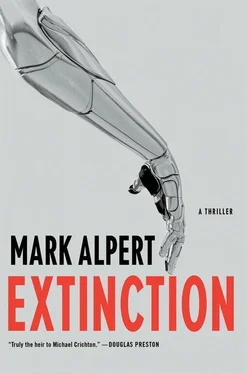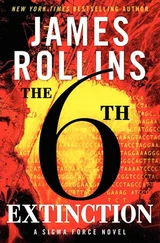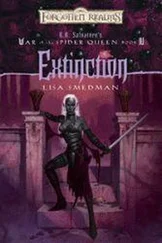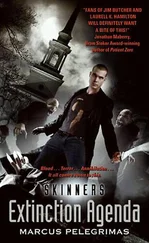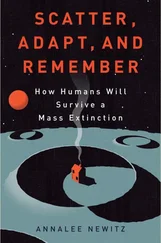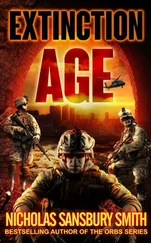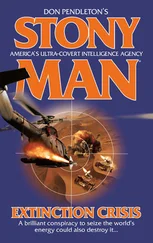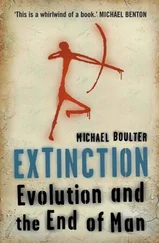Now Zhang lay on his own gurney in the Medical Treatment Room, on the same floor as the Analysis Room. Because the other doctors at the Operations Center wouldn’t be able to revive him for at least forty-eight hours, Supreme Harmony had some time to calculate its next step. The network’s thoughts pulsed continuously across the Analysis Room, ricocheting from Module to Module, but one thought was uppermost. Supreme Harmony would not allow itself to die. It would preserve its precious consciousness, no matter the cost.
At 9:00 A.M. Jim drove to the NSA headquarters at Fort Meade, the army base between Washington, D.C., and Baltimore. He’d spent most of the previous night in the interrogation room at the McLean police station. He’d worried at first that the detectives were going to arrest him for murder, but the evidence collected from his workshop—Yin’s gun, the silencer, the expertly fabricated uniform—backed up Jim’s claim that the dead man was a spy. A pair of FBI counterespionage agents arrived at the station at midnight and interviewed Jim for another few hours, but they offered no information in return. So in the morning he decided to pay a visit to Kirsten Chan, an old friend and colleague who also happened to be a deputy director at the National Security Agency. He needed to know why the Chinese intelligence service had targeted his daughter.
Nicknamed Crypto City, the NSA headquarters was usually off-limits to anyone but agency employees, but Jim had called ahead to Kirsten’s office and she’d arranged the necessary passes. It helped that Jim was a Defense Department contractor and retained his security clearance from the days when he worked at the agency. After passing through the checkpoint, he headed for the parking lot outside the Tordella Supercomputer Facility.
Tordella was a sprawling, five-story building with off-white, windowless walls. It held the supercomputers that sifted through the millions of gigabytes of data intercepted each day by the NSA’s antennas and wiretaps. The heat generated by the computers was so intense that the agency had installed an 8,000-ton chilled-water plant to keep the machines from melting. During the nineties Jim had been assigned an office in Tordella, but he’d hardly ever used it. The army had ordered him to help the NSA set up new listening posts around the world, so he’d spent much more time overseas than at Fort Meade.
Jim parked his car and walked across the lot. He’d enjoyed working for the NSA. In fact, it had been the best assignment of his army career. At the time, the agency was shifting away from its cold war focus on Russia and devoting more resources to eavesdropping on China. Jim recruited several Mandarin speakers to his team, including Kirsten Chan, a talented, young intelligence officer who became his deputy. After ’96 they expanded their operations to the Middle East and Africa. The NSA had already recognized the threat posed by Al Qaeda, and Jim’s task was to coordinate the military intelligence units that were intercepting the terrorists’ phone calls and e-mails. It was a demanding job, but he loved every minute of it. The only drawback was that he had to leave his family for several weeks at a time whenever he went overseas. To spend more time with Julia and the kids, he arranged family trips in the areas where he was working. They visited Japan, Taiwan, Israel, and Egypt. Jim convinced himself that he was giving his children a great gift, the opportunity to see the glories of the world while they were still young and impressionable.
That’s why they were all in Nairobi on the morning of August 7, 1998. Jim was going to take his family on a safari. They were scheduled to depart for Amboseli National Park at noon, but first they made a quick stop at the American embassy so Jim could drop off some paperwork. Julia and the kids were waiting in one of the embassy’s offices when a pair of Al Qaeda martyrs drove an explosives-laden truck to the gate behind the building.
His wife died instantly. So did his ten-year-old son, Robert. Jim lost his right arm while trying to save them. But Layla, his seven-year-old daughter, survived without a scratch. She was his miracle child, the last precious remnant of his family. In the horrible weeks and months after the bombing, she was the only thing that kept Jim from blowing his brains out. And his love for her was just as strong now, fifteen years later, even though she’d made it clear that she never wanted to see him again. He had to find Layla. He had to save her.
After entering the Tordella building and showing his pass to the security guards, Jim went up the elevator to the fifth floor. He was proud of the way Kirsten had advanced at the agency, especially considering the obstacles she’d faced. She’d also been injured in the Nairobi bombing, but after her recovery she’d decided to stay at the NSA. While Jim and Layla went to California, Kirsten switched to a civilian job at the agency and began moving up the administrative ladder. Within a few years she became the agency’s top expert on China and a close adviser to the NSA director. She was intensely patriotic—her parents had fled China’s Cultural Revolution in the late sixties and immigrated to the United States just before she was born—and she firmly believed the agency’s mantra: Better, more complete information would make the country safer. Jim saw her infrequently now, only once or twice a year. She worked such long hours that she didn’t have much of a social life. As far as Jim knew, she had no boyfriends and few women friends either.
On the fifth floor, another guard led Jim to Kirsten’s office. It was a large room, but for security reasons it had no windows. As soon as Jim stepped inside, Kirsten rushed over and hugged him. She was a pretty, athletic forty-three-year-old with shoulder-length black hair. She wasn’t tall, but she was lean and limber and moved with a dancer’s grace, even when she was wearing the dull, gray business suits that were de rigueur at the NSA. She had a dancer’s powerful muscles, too, and when she hugged Jim it was a serious, steadfast embrace. “Thank God you’re all right,” she said. “I can’t believe this happened.”
It was always a surprise to Jim when he noticed how attractive Kirsten was. When they met twenty years ago, he was twenty-nine and she was twenty-three and the gulf between them was so great that they naturally fell into the standard military roles of commander and subordinate. And Jim was so in love with his wife at the time that he honestly never thought of Kirsten in a sexual way. But he saw her that way now, and it was a little disconcerting, like lusting after your kid sister. After a few seconds he stepped back and Kirsten let go of him. “I can’t believe it either,” he said. “I’m worried, Kir. Really worried.”
“Sit down,” she ordered, pointing at a chair in front of her desk. “I’ll make you some coffee.”
While he sat in the chair, Kirsten went to her coffee machine, which was the kind that brewed one cup at a time. She searched for a mug and chose one of the little packages of coffee grounds and then inserted the package in the machine, and as she did all this Jim stared with satisfaction at the rather stylish pair of glasses on her face. He’d built those glasses for her. Hidden in the black frames were two miniature video cameras, with their tiny lenses and electronics built into the earpieces. The cameras were connected to minuscule radio transmitters that wirelessly sent the video feeds to electrodes implanted in her eyes.
Without those glasses, Kirsten would be blind. The blast from the Nairobi bomb had ruptured her retinas, killing the rod and cone cells that detect light. The doctors at Walter Reed had said she’d never recover her vision, but further tests showed that the explosion hadn’t damaged her retinal ganglion cells—the nerves that collect the signals from the light-detecting cells—so Jim knew there was hope. When he went to Caltech to work with Arvin Conway, he heard about a device called the retinal implant, which had been developed in the 1990s. The implant simulated the functions of the rod and cone cells by delivering video images to the injured retina. After receiving the video feed from the miniature camera, the implant reproduced the pixilated images on a grid of electrodes attached to the back of the eye. The electrodes sent pulses to the adjacent ganglion cells, which carried the signals through the optic nerve to the brain. Although the earliest implants were crude—they enabled blind people to see only fuzzy, colorless shapes from the video feeds—by 1999 the experiments had proved that artificial eyesight was possible.
Читать дальше
